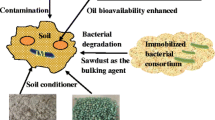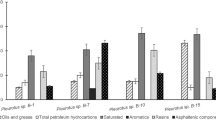Abstract
A commercial strain of the fungus Pleurotus ostreatus was used to mediate the degradation of lindane, by landfarming technology during a 4 weeks statistical experiment. The Multilevel Factorial Design was used with two design factors, namely, straw content X 1 (%) and lindane content X 2 (ppm). The optimization parameters (responses) investigated were: biodegradation rate Y 1 (μg d−1), biomass growth rate Y 2 (mg d−1), biodegradation/biomass Y 3 (μg mg−1), total organic carbon Y 4 (%), total organic nitrogen Y 5 (%) and total organic carbon/total organic nitrogen Y 6. The optima of the adequate models obtained for the period of 2 and 4-weeks were found. An overall kinetic study, conducted in this work with the aid of experimental design, determined the optimum (maximum) specific lindane degradation rate to be 0.16 g kg−1 month−1.


Similar content being viewed by others
References
Aidoo, K. E., Hendry, R., & Wood, B. J. B. (1981). Estimation of fungal growth in a solid state fermentation system. European Journal of Applied Microbiology, 12, 6–9.
Boyle, C. D. (1995). Development of practical method for inducing white rot fungi to grow into and degrade organopollutants in soil. Canadian Journal of Microbiology, 41, 345–353.
Gavrilescu, M. (2005). Fate of pesticides in the environment and its bioremediation. Engineering in Life Science, 5, 497–525.
Kirk, T. K., Lamar, T., & Glaser, J. A. (1992). The potential of white rot fungi in bioremediation.. In S. Mongkolsuk, P. S. Lovett, & J. E. Trempy (Eds.), Biotechnology and environmental science: Molecular approaches (pp. 131–138). New York: Plenum.
Kumar, M., Chaudhary, P., Dwivedi, M., Kumar, R., Debarati, P., Jain, R., et al. (2005). Enhanced biodegradation of b- and δ-hexachlorocyclohexane in the presence of a- and δ-isomers in contaminated soils. Environmental Science & Technology, 39, 4005–4011.
Papadopoulou, K., Rigas, F., & Doulia, D. (2006a). Bioremediation of Lindane contaminated soil by the white rot fungus Pleurotus ostreatus via fractional Central Composite Design. In IASME/WSEAS International Conference on Energy, Environment, Ecosystems & Sustainable Development, Greece.
Papadopoulou, K., Rigas, F., & Doulia, D. (2006b). Lindane degradation in soil by Pleurotus ostreatus. WSEAS Transactions on Environment and Development, 5(2), 489–496.
Philippoussis, A., Zervakis, G., & Diamantopoulou, P. (2001). Bioconversion of lignocellulosic wastes through the cultivation on the edible mushrooms Agrocybe aegerita, Volvariella volvacea, and Pleurotus spp. World Journal of Microbiology & Biotechnology, 17, 191–200.
Phillips, T. M., Lee, H., Trevors, J. T., & Seech, A. G. (2006). Full-scale in situ bioremediation of hexachlorocyclohexane-contaminated soil. Journal of Chemical Technology and Biotechnology, 81, 289–298.
Pointing, S. (2001). Feasibility of bioremediation by white rot fungi. Applied Microbiology and Biotechnology, 57, 20–33.
Ride, J. P., & Drysdale, R. B. (1972). A rapid method for the chemical estimation of filamentous fungi in plant tissue. Physiological Plant Pathology, 2, 7–15.
Rigas, F., Dritsa, V., Marchant, R., Papadopoulou, K., Avramides, E. J., & Hatzianestis, I. (2003). Biodegradation of lindane by Pleurotus ostreatus via central composite design. In 2nd European Bioremediation Conference, Chania, Greece.
Rigas, F., Dritsa, V., Marchant, R., Papadopoulou, K., Avramides, E. J., & Hatzianestis, I. (2005a). Biodegradation of lindane by Pleurotus ostreatus via central composite design. Environment International, 31, 191–196.
Rigas, F., Papadopoulou, K., Dritsa, V., & Doulia, D. (2007). Bioremediation of a soil contaminated by lindane utilizing the fungus Ganoderma australe via response surface methodology. Journal of Hazardous Materials, 140, 325–332.
Rigas, F., Papadopoulou, K., Dritsa, V., & Marchant, R. (2005b). Bioremediation of soil polluted with Lindane by Pleurotus ostreatus. In 3rd European Bioremediation Conference, Chania, Greece.
Scotti, T. C., Vergoignan, C., Feron, G., & Durand, A. (2001). Glucosamine measurement as indirect method for biomass estimation of Cunninghamella elegans grown in solid state cultivation conditions. Biochemical Engineering Journal, 7, 1–5.
Shah, M. M., Barr, D. P., Chung, N., & Aust, A. D. (1992). Use of white rot fungi in degradation of environmental chemicals. Toxicology Letters, 64, 493–501.
Viladi, M. (2001). Bioremediation. An overview. Pure and Applied Chemistry, 73, 1163–1172.
Acknowledgement
This work was supported by the grant 01ED45 from the Greek General Secretariat of Research and Technology under the PENED 2001 programme.
Author information
Authors and Affiliations
Corresponding author
Rights and permissions
About this article
Cite this article
Rigas, F., Papadopoulou, K., Philippoussis, A. et al. Bioremediation of Lindane Contaminated Soil by Pleurotus ostreatus in Non Sterile Conditions Using Multilevel Factorial Design. Water Air Soil Pollut 197, 121–129 (2009). https://doi.org/10.1007/s11270-008-9795-8
Received:
Accepted:
Published:
Issue Date:
DOI: https://doi.org/10.1007/s11270-008-9795-8




